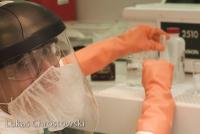Author:
Mark Bachman, Spring 2002. Adapted for AMPEL ANF, M. Beaudoin, April 2014.
Overview:
Dilute hydrofluoric acid (HF) is used to remove native silicon dioxide from wafers. Since it acts quickly, one needs to only expose the wafer for a short time (“dip”). HF is a dangerous chemical and protective gear must be worn when using it, in particular, acid (orange) gloves, apron and full facial and eye protection must be worn. This note describes how to prepare a 2% solution. Alternatively, the ANF supplies already prepared 1:7 and 1:10 HF containing BOE (Buffered Oxide Etch) solution. This is a dangerous wetbench process and requires qualification for dangerous wetbench processes. The use of dangerous chemicals requires that the user may not perform the process alone (buddy system).
Time Needed:
Setup time for this process is about 5 minutes. This process takes about 5 minutes to complete.
Materials Needed:
- Extra heavy gloves (orange acid gloves, make sure they have NO HOLES)
- Polymer beaker (Teflon or polypropylene)
- 20 ml HF (49%)
- Small polypropylene graduated cylinder (for 20 ml)
- Large graduated cylinder (for 500 ml)
Preparation:
Setup time for this process is about 5 minutes. This process takes about 5 minutes to
complete. You will need to measure the following:
- 480 ml water
- 20 ml HF (49%)
Don all protective equipment: apron, nitrile gloves, acid gloves, eye protection, full face shield. Add 480 ml water to polypropylene beaker, then add 20 ml HF. Never use a glass beaker with HF since HF attacks glass. Label the bottle “2% HF solution—Dangerous acid!”, then add your name and the date.
Procedure:
Soak the wafer for 1-2 minutes in the 2% HF solution. Remove the wafer and rinse in running DI water. Check for hydrophobicity by performing a wetting test. Pour a little DI water on the surface. If the water beads up and rolls off, the surface is hydrophobic and water will not wet it. Since oxide is hydrophilic and pure silicon is hydrophobic, a non-wetting surface is clean of oxides. Blow dry with nitrogen and store in a clean, dry environment.
The 2% solution may be saved for other cleaning (it does not lose its effectiveness). To dispose the 2% HF solution, pour into an ANF labeled waste container for BOE and HF (under the wetbench in the same secondary container as HF). Do so very carefully: put the waste bottle in the sink, pour the waste solution in the bottle (you may use a polypropylen funnel), cap the bottle, rinse the outside with the DI water gun, wipe bottle and store, rinse wipe thoroughly with DI water and dispose in waste can. Very small amounts (ie. a spill on the bench) of 2% HF may be disposed by diluting with DI water, then flushing down the drain with plenty of water. Rinse beakers thoroughly with water when finished. Be sure to wash your neoprene or heavy nitrile gloves and return to their proper location when finished.
Cleanup:
Rinse all beakers, graduated cylinders, mixers and labware with DI water. Wipe up any spills. Rinse outer gloves and hang to dry.
Safety & Emergency:
All ANF safety and procedural regulations must be followed. Hydrofluoric acid (HF) is an extemely toxic and dangerous acid. Use of HF requires at least one other person in the clean room (buddy system). HF should be handled in a laminar flow bench, using nitrile gloves inside the acid (orange) gloves, apron, eye protection and full face shield. Any small spills should be wiped up immediately with wipes and rinsed. Rinse the wipes with lots of DI water and dispose of in the waste can. NEVER LEAVE the etchant unattended.
In case of exposure to HF Seek medical attention immediately! For skin exposure, flush immediately with water for 5 minutes followed by liberal application of calcium gluconate gel to the skin. Remove all clothing that are exposed before and while flushing with water. For eye exposure, flush the eyes with water three times, 5 minutes each. Irrigate the eye repeatedly with 500-1000 ml of a 1% calcium gluconate solution applied through a syringe. Call for prompt emergency room transport. Apply ice-water compresses during transport. In case of large spill, EVACUATE THE CLEANROOMS IMMEDIATELY and activate the evacuation alarm.
References:
- W. Kern and J. Vossen, Thin Film Processes, Academic Press: New York, 1978, Ch V-1.
- Northwestern University Office of Research Safety (ORS) safety documents, http://www.northwestern.edu/research-safety/index.htm.
